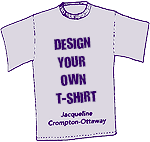|
Title: Design Your Own T-shirt
|
Publisher: Jabberwocky v10,No3, Jan 1995.
|
|
Introduction:
This article is called Design Your Own T-Shirt.
It gives ideas about the kind of design you may like to put on your shirt, and about how to choose the right paint.
Probes: Can you tell me about...
1. ...what type of design you can put on your T-shirt.
2. ...what sort of paints you use.
Questions:
1. What patterns are more effective?
Show me where it says that.
2. What sort of things do you need to consider before painting a T-shirt?
3. Suggest some ways in which the skills you might develop in painting T-shirts could be used for other purposes.
|
Text:
Sometime, when you've got nothing to do during the summer holidays, you might like to paint a T-shirt for yourself. Fabric paints are available at most stationery shops, fabric shops and art supply shops.
Creating your design
1. Before you buy your paints, it's best to work out exactly what picture you want to paint on your T-shirt. You might want to paint an abstract design, an animal, a clown face or a special hobby that you enjoy (e.g. a paint brush and palette, a boat, rugby ball, violin etc.) Remember that bold, bright patterns look more striking and are more
effective!
2. If you don't feel happy working out your own design, then look through a colouring-in book for fresh ideas. You can always trace the pictures and transfer them onto your T-shirt, if you don't want to draw them free-hand.
[Excerpt]

|